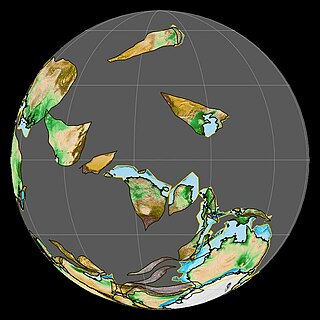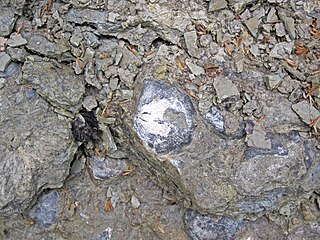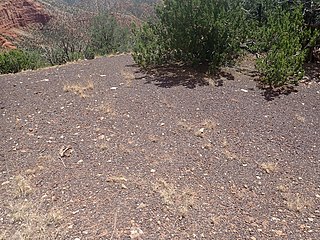
The Serpukhovian is in the ICS geologic timescale the uppermost stage or youngest age of the Mississippian, the lower subsystem of the Carboniferous. The Serpukhovian age lasted from 330.9 Ma to 323.2 Ma. It is preceded by the Visean and is followed by the Bashkirian. The Serpukhovian correlates with the lower part of the Namurian Stage of European stratigraphy and the middle and upper parts of the Chesterian Stage of North American stratigraphy.

The Madison Limestone is a thick sequence of mostly carbonate rocks of Mississippian age in the Rocky Mountain and Great Plains areas of the western United States. The rocks serve as an important aquifer as well as an oil reservoir in places. The Madison and its equivalent strata extend from the Black Hills of western South Dakota to western Montana and eastern Idaho, and from the Canada–United States border to western Colorado and the Grand Canyon of Arizona.

The Rundle Group is a stratigraphical unit of Mississippian age in the Western Canadian Sedimentary Basin.

The Arnheim Formation is a geologic formation in Ohio. It preserves fossils dating back to the Ordovician period.
The Pennington Formation is a geologic formation named for Pennington Gap, Virginia. It can be found in outcrops along Pine Mountain and Cumberland Mountain in Kentucky, Virginia, and Tennessee, where it is the uppermost Mississippian-age formation. The name has also been applied to similar Mississippian strata in the Cumberland Escarpment of eastern Kentucky, though the rocks in that area were later renamed to the Paragon Formation.
The Bowen Formation is an Ordovician-age geological formation in the Appalachian region of the eastern United States. It occupies a thin stratigraphic range between the Wardell and Witten formations in some areas of southwest Virginia and northeast Tennessee. It is particularly well-exposed in Tazewell County, Virginia. Unlike its encompassing strata, the Bowen Formation is mostly calcareous sandstone and mudrock rather than limestone. The thicker upper part of the formation is composed of layered red mudrock which is replete with mudcracks. The thinner lower part, which is not always preserved, is a coarser unit of dark grey stratified sandstone which weathers to a rusty-brown color. Fossils are rare, restricted to stromatolites and Tetradium fibratum.

The Bangor Limestone is a fossil bearing Mississippian geologic formation in northern Alabama. It is a shallow marine carbonate formation in the Chesterian series.

The Burlington Limestone is a geologic formation in Missouri, Iowa and the Midwest region. It preserves fossils dating back to the Mississippian subperiod.

The Deadwood Formation is a geologic formation of the Williston Basin and Western Canada Sedimentary Basin. It is present in parts of North and South Dakota and Montana in the United States, and in parts of Alberta, Saskatchewan, and southwestern corner of Manitoba in Canada. It is of Late Cambrian to Early Ordovician age and was named for exposures in Whitewood Creek near Deadwood, South Dakota. It is a significant aquifer in some areas, and its conglomerates yielded significant quantities of gold in the Black Hills of South Dakota.

The Pahasapa Formation is a geological unit of primarily limestone and dolomite that is exposed in the Black Hills of South Dakota and northeastern Wyoming, and underlies parts of Nebraska, in the United States. Also referred to as the Pahasapa Limestone, this unit is analogous to the Madison Limestone, the Lodgepole Limestone, and the Burlington Limestone, other Mississippian-aged limestones and dolomites in the midwestern United States. Some recent literature has grouped stretches of the Pahasapa into the Madison Group. The formation is of local importance, as it contains the Madison aquifer, and two of the ten longest caves in the world.
The Welden Limestone is a geologic formation in Oklahoma. It preserves fossils dating back to the Carboniferous period. It is restricted to the Lawrence Uplift of southern Oklahoma. In this region, the Welden Limestone is the only carbonate unit deposited during the span of time from Late Devonian to the Pennsylvanian.
The Belle Fourche Formation or Belle Fourche Shale is a fossiliferous early Late-Cretaceous geologic formation classification in Wyoming. Named for outcrops in Belle Fourche River, Wyoming, this unit name is also used in Montana, North Dakota, and South Dakota.

The Sandia Formation is a geologic formation in New Mexico, United States. Its fossil assemblage is characteristic of the early Pennsylvanian.
The Ely Limestone is a geologic formation in Nevada and Utah. It preserves fossils dating back to the Carboniferous period.
The Diamond Peak Formation is a geologic formation in Nevada. It preserves fossils dating back to the Carboniferous period.
The Goughs Canyon Formation is a geologic formation in southeastern Humboldt County, Nevada.
The Poway Group is a geologic group in San Diego County, Southern California. It preserves fossils dating back to the Paleogene period.

The Tunnel Mountain Formation is a geologic formation that is present on the western edge of the Western Canada Sedimentary Basin in the Canadian Rockies of western Alberta. Named after Tunnel Mountain near Banff, it was deposited during the Early Pennsylvanian sub-period of the Carboniferous period.
The Kootenay Group, originally called the Kootenay Formation, is a geologic unit of latest Jurassic to earliest Cretaceous age in the Western Canada Sedimentary Basin that is present in the southern and central Canadian Rockies and foothills. It includes economically important deposits of high-rank bituminous and semi-anthracite coal, as well as plant fossils and dinosaur trackways.

The Log Springs Formation is a geologic formation in the Jemez, Nacimiento, and Sandia Mountains of New Mexico. Its age is poorly constrained but is thought to be Namurian.










